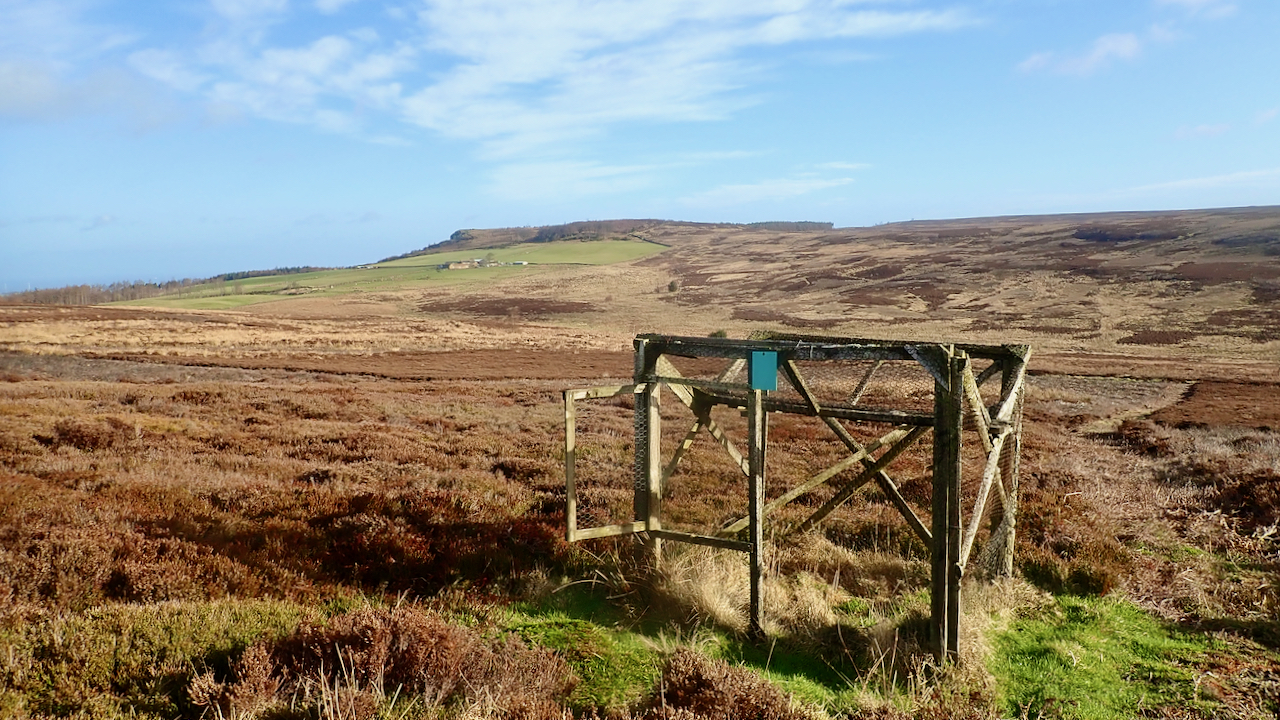I thought I would pop along to see if this ladder trap I last visited a couple of years ago had been in use. It doesn’t look like it. The dead crow that was there previously has long since long and the access gate was left open.
Although these traps are not selective, birds of prey are known to have been caught, crows are the ‘target species’. As an example, in 2005, two gamekeepers from West Wycombe in Berkshire were convicted of killing a buzzard they found in their crow multi-trap.
Ever since Neolithic man settled down to plant his grain and rear his livestock he has been in a constant battle with those fauna which seizes upon the opportunity for an easy meal whether it be animals, insects, or birds. It’s quite likely the crow would have been there at the start.
In the north of England, the carrion crow was thought in Victorian times to have been more numerous than in any country in the world. ‘Black-neb‘, ‘corby‘, ‘dowp‘, ‘midden-crow‘, and ‘craw‘ are some of the many names given to this troublesome bird by farmers and gardeners.
A Tudor Act of parliament decreed that churchwardens of every parish had to levy a rate or tax on every farmer or landowner which was to be paid out as bounties for ‘the destruccyon of noyfull Fowles and Vermin’1“New Scientist.” Google Books, 2013, books.google.co.uk/books?id=AmDwg1dhJXgC&pg=PA681&lpg=PA681&dq=noyfull+fowles+and+vermin&source=bl&ots=GRBC-x1mjf&hl=en&sa=X&ved=2ahUKEwiy4ILQx4XvAhVEQEEAHdTDBNs4ChDoATAAegQIAxAD#v=twopage&q&f=false. Accessed 25 Feb. 2021. which would include crows.
The practice is a time honoured method of pest control. The Ancient Greeks and then the Romans are recorded as offering bounties for the killing of various vermin2“New Scientist.” Google Books, 2013, books.google.co.uk/books?id=AmDwg1dhJXgC&pg=PA681&lpg=PA681&dq=noyfull+fowles+and+vermin&source=bl&ots=GRBC-x1mjf&hl=en&sa=X&ved=2ahUKEwiy4ILQx4XvAhVEQEEAHdTDBNs4ChDoATAAegQIAxAD#v=twopage&q&f=false. Accessed 25 Feb. 2021..
On the Cawdor estate in Scotland, bounties were paid out on 14,000 red squirrels between 1862 and 1878. Yes, you read that right, ‘red’ squirrels. But apparently a bunch of red squirrel tails was spotted arriving by train addressed to the keepers. In another case, an English MP, who was the sporting tenant of the Glengarry estate between 1837 and 1840, paid bounties on 4,874 heads of predators including 198 wild cats, 246 pine martens, 106 polecats, 275 red kites and 371 rough-legged buzzards. It is estimated that the counts of some of these species are actually more that had ever been seen within a hundred miles of Glengarry3“New Scientist.” Google Books, 2013, books.google.co.uk/books?id=AmDwg1dhJXgC&pg=PA681&lpg=PA681&dq=noyfull+fowles+and+vermin&source=bl&ots=GRBC-x1mjf&hl=en&sa=X&ved=2ahUKEwiy4ILQx4XvAhVEQEEAHdTDBNs4ChDoATAAegQIAxAD#v=twopage&q&f=false. Accessed 25 Feb. 2021..
And I guess therein lies one of the problems with the use of bounties as a means of pest control. Fraud. Never mind the practice being biologically ineffective.
In British colonial India, the government was concerned about the number of venomous cobras in Delhi. A bounty was therefore offered for every dead snake. At first, this was seen as a success with large numbers of snakes being killed for the reward. However, some enterprising townsfolk soon began to breed cobras. When the government clocked the ruse, the bounty was scrapped and the cobra breeders set their snakes, now-worthless ,free, with the consequence that the cobra population increased more than when the bounty started4Wikipedia Contributors. “Cobra Effect.” Wikipedia, Wikimedia Foundation, 16 Feb. 2021, en.wikipedia.org/wiki/Cobra_effect. Accessed 25 Feb. 2021. .
This phenomena, when incentives designed to solve a problem and ending up actually making it worse, is known in economics as The Cobra Effect.
[Ref043]
- 1“New Scientist.” Google Books, 2013, books.google.co.uk/books?id=AmDwg1dhJXgC&pg=PA681&lpg=PA681&dq=noyfull+fowles+and+vermin&source=bl&ots=GRBC-x1mjf&hl=en&sa=X&ved=2ahUKEwiy4ILQx4XvAhVEQEEAHdTDBNs4ChDoATAAegQIAxAD#v=twopage&q&f=false. Accessed 25 Feb. 2021.
- 2“New Scientist.” Google Books, 2013, books.google.co.uk/books?id=AmDwg1dhJXgC&pg=PA681&lpg=PA681&dq=noyfull+fowles+and+vermin&source=bl&ots=GRBC-x1mjf&hl=en&sa=X&ved=2ahUKEwiy4ILQx4XvAhVEQEEAHdTDBNs4ChDoATAAegQIAxAD#v=twopage&q&f=false. Accessed 25 Feb. 2021.
- 3“New Scientist.” Google Books, 2013, books.google.co.uk/books?id=AmDwg1dhJXgC&pg=PA681&lpg=PA681&dq=noyfull+fowles+and+vermin&source=bl&ots=GRBC-x1mjf&hl=en&sa=X&ved=2ahUKEwiy4ILQx4XvAhVEQEEAHdTDBNs4ChDoATAAegQIAxAD#v=twopage&q&f=false. Accessed 25 Feb. 2021.
- 4Wikipedia Contributors. “Cobra Effect.” Wikipedia, Wikimedia Foundation, 16 Feb. 2021, en.wikipedia.org/wiki/Cobra_effect. Accessed 25 Feb. 2021.

Leave a Reply